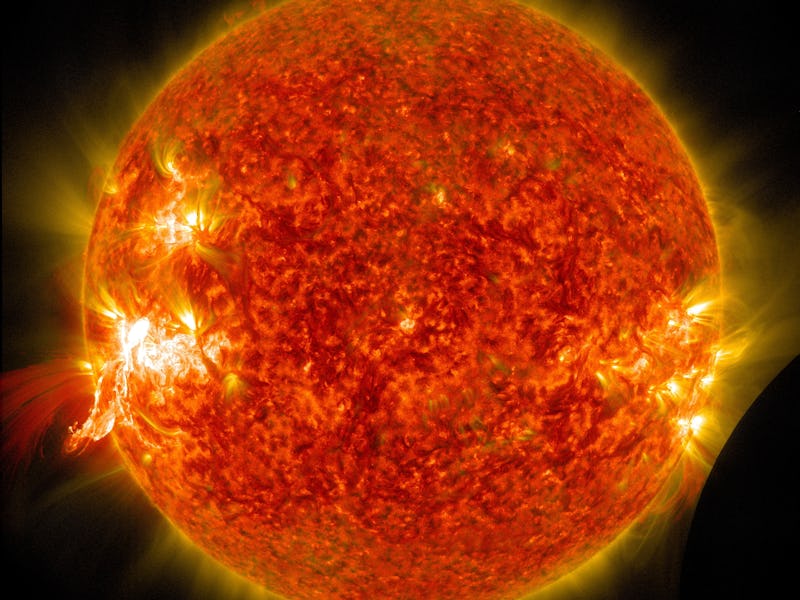We Could Have Fusion Energy by 2030, Says Guy Who Knows
The big trick is shrinking the size of the reactors.

The reality of clean, stable energy produced in a ball of plasma seems to perpetually be around the corner. Although fusion energy hasn’t yet managed to become cheap and stable enough to power the electrical grid, researchers think we are finally getting close to that point.
If we chase fusion aggressively enough, we could potentially have it on the grid by 2030, Earl Marmar, head of MIT’s Alcator C-Mod fusion project tells Inverse.
The physics of fusion is pretty well understood at this point, and so the remaining challenges are mainly technological, he says. Currently, there are a few promising methods to get stable fusion, including changing the shape of the reactor and using high-temperature superconducting magnets. Marmar thinks fusion will be the power source to get us to a clean energy future, but he thinks we haven’t invested enough to solve the remaining technical issues facing fusion, which could delay the timeline.
“I think fusion energy on the grid by 2030 is certainly within reach by this point,” says Marmar. “2030 is probably aggressive, but I don’t think it’s wildly out of range.”
Marmar, hopeful about fusion
Where nuclear power relies on splitting apart large radioactive atoms to release energy, fusion smooshes together small hydrogen atoms to form larger atoms in a 200 million degree plasma to release energy. Fusion reactions happen in donut-shaped vacuum chambers called tokamaks.
The inside of a tokamak fusion reactor. The plasma that creates fusion is trapped within this donut-shaped space by the magnetic fields created by the machine.
Electricity runs through the center of the donut, and the outside edges are circled with electromagnets. Gas is pumped into the chamber and charged by electricity running in the hole of the donut. This turns it into plasma, which hovers in the chamber because of the magnetic fields. As the pressure and temperature of the gas increases, fusion happens when atomic nuclei squish together.
“So we know that fusion works; we know that the nuclear physics works. There are no questions from the nuclear physics,” says Marmar. “There are questions left on the technology side.” Currently, the problem with fusion is that researchers haven’t been able to get the reaction to be sustainable for long enough that it can actually produce energy. So far, fusion has produced less energy than it takes to run the machine to create the reaction. He says, to be cost-competitive, the reactors mainly need to be smaller.
And Marmar says there are a few good technological solutions that could solve the problem. In the UK, Tokamak Energy has decreased the size of the donut hole in their tokamak to try and get more plasma compared to the total pressure and magnetic energy. This would potentially allow for a fusion reaction that was smaller and, therefore, cheaper to run. “That may well be true but not demonstrated yet. And I hope they will be successful,” he says.
At MIT, the focus has been to increase the strength of the magnetic field. While their reactor is currently shut down, Marmar and his team have been looking into high temperature superconductive magnets. High temperature superconductive magnets can work at temperatures of about 100 degrees warmer than the electromagnets typically used on tokamaks, which have to be super-cooled to -239 degrees Celsius to work. This saves a lot of energy, and these magnets offer stronger magnetic fields. “We think that opens a new pathway for more efficient utilization of the magnetic field, which could be a faster and more economical way to get fusion energy actually on the grid,” says Marmar.
The tokamak is an experimental machine designed to harness the energy of fusion.
Fusion energy has the potential to replace coal as a way to power cities in the future, says Marmar. He has a hard time imagining replacing the high-density power plants that run cities with solar or wind. “We need to get going, because the need for fusion energy is very urgent, specifically in view of climate change,” he says. And right now, even with ITER, the enormous fusion reactor experiment funded by 35 countries, including the U.S., Marmar doesn’t think we are putting enough pressure on fusion. This could set things back ‘til 2040, he says.
“We’re not there yet, and there may be bumps along the way,” says Marmar. “With a sufficiently aggressive program, and I think 2030 might be too aggressive, but I think close to that.”